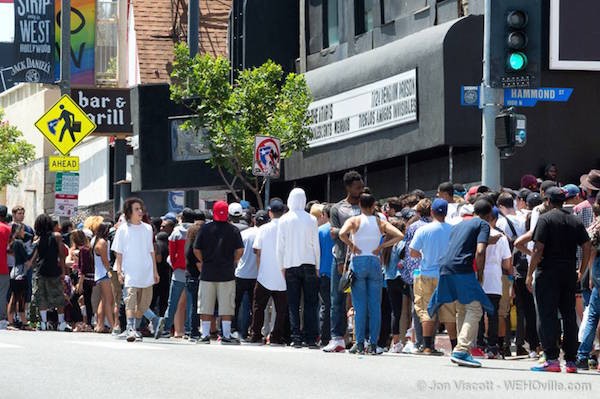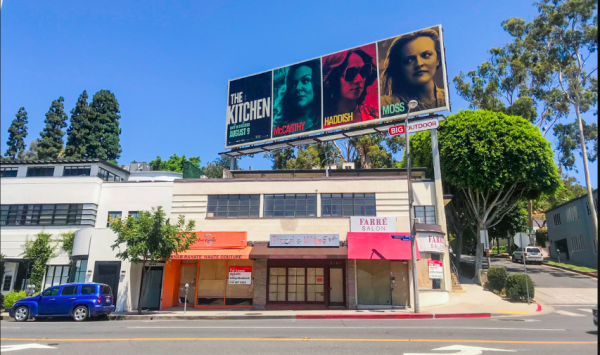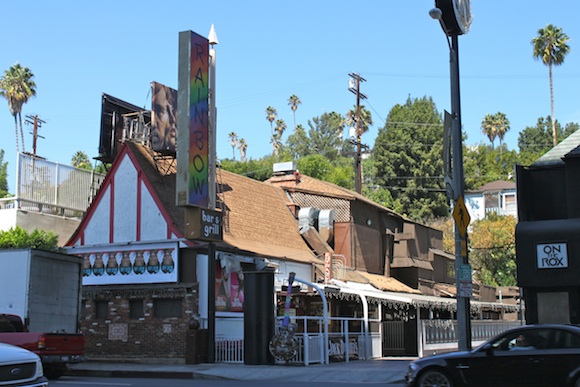With unanimous votes on Wednesday, West Hollywood’s Historic Preservation Commission (HPC) approved historic designations for three buildings on the Sunset Strip. However, the Commission delayed a vote on a fourth Sunset Boulevard building when a commissioner had to recuse himself from that discussion.

The Roxy Theatre building at 9009 Sunset Blvd., the Rainbow Bar and Grill building at 9015 Sunset Blvd., and the Sentney building at 9157 Sunset Blvd., were all granted designations as “local cultural resources.” With this designation, the buildings can qualify for property tax reductions and less stringent zoning requirements, but owners must get city approval to significantly alter (or demolish) the buildings.
Meanwhile, HPC was unable to consider a historic designation for the Whisky a Go Go building at 8901 Sunset Blvd. (at Clark Avenue) as Commissioner Jake LaJoie recused himself because he lives within 500 feet of the Whisky building. LaJoie’s recusal, plus the absence of two other commissioners and the resignation of a third commissioner, left the Commission with only three members present for the Whisky discussion. Four members are needed for a quorum on the seven-member commission, so the Commission was unable to conduct business regarding the Whisky building.
LaJoie’s recusal only affected the Whisky designation; he participated in the other three.
Fueling these historic designations is the city’s plan to expand the number of billboards on the Sunset Strip and to allow a few existing Strip billboards to convert to digital billboards. Under that plan, buildings that are approved for historic designation get special consideration for digital billboard conversion. Three of the four buildings (the Rainbow, the Whisky and the Sentney building) already have billboards and thus can apply for the digital upgrade. The deadline for digital conversion applications is Nov. 4.
The Whiskey’s historic designation will be considered at the Commission’s Oct. 28 meeting. If the Commission approves that designation, which it likely will, the Whisky will still have time to get in its digital billboard conversion application before the deadline.

HPC will have no say in which digital billboard applications are approved since that is beyond its purview. Nonetheless, the commissioners were happy the owners were submitting them for historic designation, even if the billboards were the motivating factor.
“There is no bad reason to bring forward nominations for these properties,” said Commissioner Ed Levin.
Built in 1936 in French Revival style from designs by architect Paul Ecke, the Roxy Theater building originally opened as a grocery store, but in 1956 became a nightclub, the Largo. With the backing of record company executives, the building was renovated and opened as the Roxy Theatre in Sept. 1973. It became a renowned performance spot for top musical acts of the 1970s including Bruce Springsteen, Billy Joel, Hall & Oates, the Ramones and the Sex Pistols. The Commission approved the historic designation because the Roxy is strongly identified with events contributing to music history in West Hollywood and the making of West Hollywood.
Next door to the Roxy, the Rainbow Bar and Grill building, built in Tudor Revival style in 1935 from designs by Paul Ecke, housed several cafes and restaurants over the years. After numerous alterations and additions, it opened in April 1972 as the Rainbow, then an exclusive restaurant catering to the musical acts of the 1970s, a time when many of the Los Angeles’s finer restaurants would not seat the rock and rollers who had reputations for their excesses and eccentricities. The Commission approved its historic designation due to its connection to the history of music in West Hollywood as well as its part in the making of modern-day West Hollywood.

The Sentney building, located on the northwest corner of Sunset and Cory Avenue, was designed in Streamline Moderne style by Ronald Webb and constructed by Ralph Sentney in 1938. Largely unchanged since that time, the building with its horizontal massing, flat roof, smooth stucco wall cladding, minimal ornamentation and rounded corners was approved because it is one of the few examples of Streamline Moderne architecture left in the city.
The Commission had minimal discussion regarding these buildings since approval was virtually a given.
During the public comment period, resident Sheila Lightfoot urged approval of the applications because of how the Rainbow and Roxy (and the Whisky) factor into the city’s rich history.
“It’s rare for a city to come into being with so much history,” said Lightfoot. “The city is so fortunate to be able to claim that history as its story. These three venues are a very big part of that story. I don’t think anyone can dispute that we have used that story and these venues to build upon to make ourselves a city that is recognized around the world.”
Meanwhile, resident Dan Morin commented that to not approve historic designation for these buildings would be “an abomination.”
The West Hollywood Preservation Alliance also supported approval of all the buildings.
Although HPC normally meets on the final Monday of the month, the September meeting was delayed by two days due to the Jewish holiday of Rosh Hashanah falling on Sept. 29 to Oct. 1 this year.
Commissioner Yawar Charlie was absent due to a death in his family. Commissioner Gail Ostergren was absent as she was out of town. City Councilmember John Duran’s appointee, Christopher Winters, resigned from the Commission in September and Duran has not yet appointed anyone to replace him.
During public comment at the close of the meeting, resident Lynn Russell suggested the Historic Preservation Commission should meet in the City Council Chamber in West Hollywood Park rather than the Community Center in Plummer Park, where the HPC meetings are routinely held. Russell noted that meetings held in the Council Chamber can be televised (City Council, Planning Commission and Rent Stabilization Commission meetings are held there and are always televised), plus the Council Chamber has better acoustics and technical equipment. Russell said that televising the HPC meetings would allow more people to understand the work the Commission does and help them better appreciate historic preservation in general.

I sure hope they plan to clean/upgrade them up, they all look like they’ve had their day and are in desperate need of some upkeep. I love historic buildings and history but these building’s aren’t being treated well. Why will this change anything? Rock and roll is over. If the city wanted to preserve this section of history then why was the House of Blues demolished. Viper room will be a hotel now. At least take care of these places, they look like dumps.
The Viper Room is currently in the plans with the new developer. Also ALL images shown in this article are old. Rainbow & Roxy have both had improvement and additions. Signage, paint,new designed bathrooms, ,etc for starters.
I couldn’t agree more. I’m not a music person, but over the years was shocked at so called LEGENDARY clubs.
Small, dirty, dank & no sign of anyone considering ever updating, improving or just cleaning.
Where was the HPC when Preston Sturges’s Player’s Club on the Strip was defaced almost beyond recognition?
Great! Save them now before the buildings are sold to a greedy developer with a wrecking ball and plans for a 20 story luxury hotel with street level retail that will be vacant for years. The Rock and Roll history of the Sunset strip deserves preservation.
100%